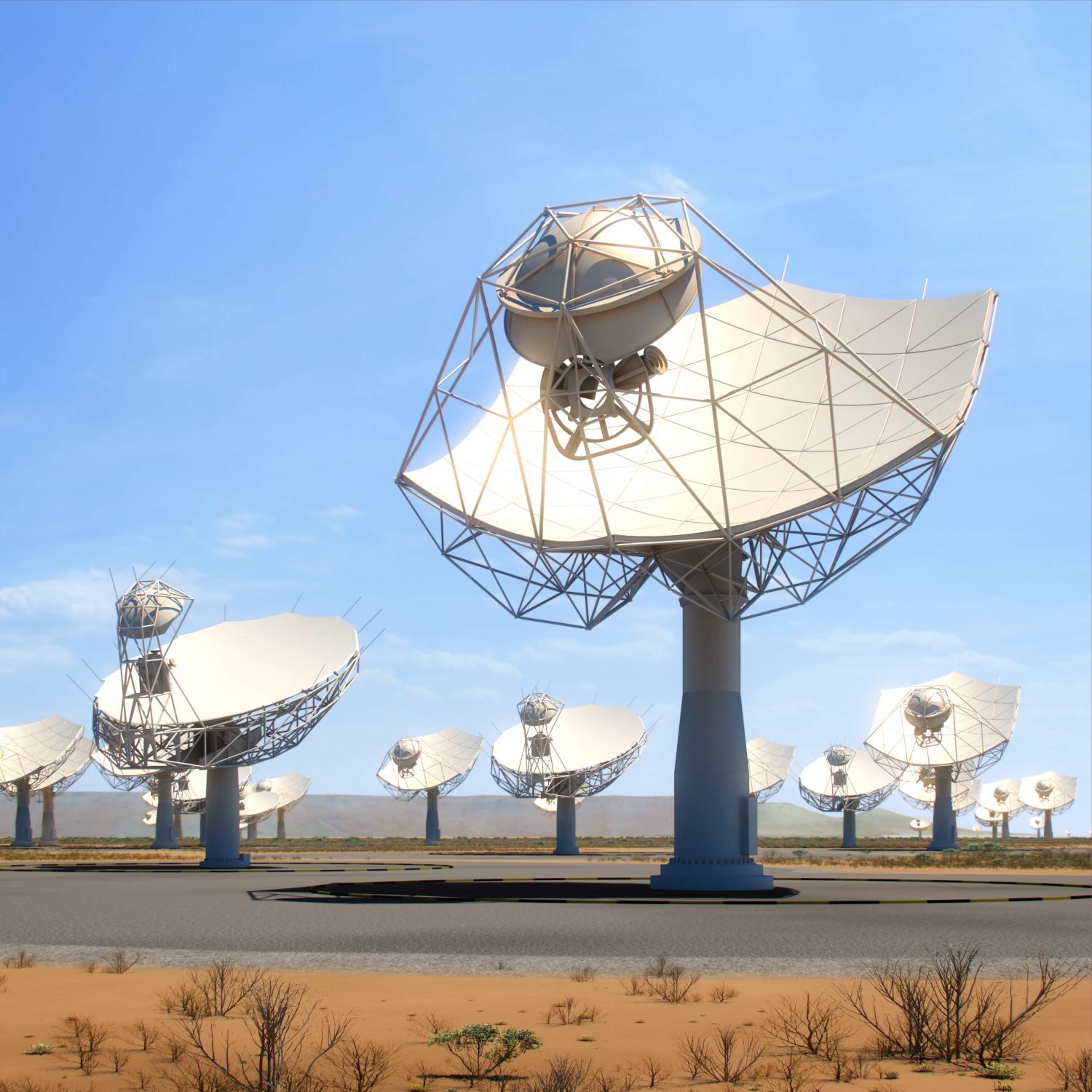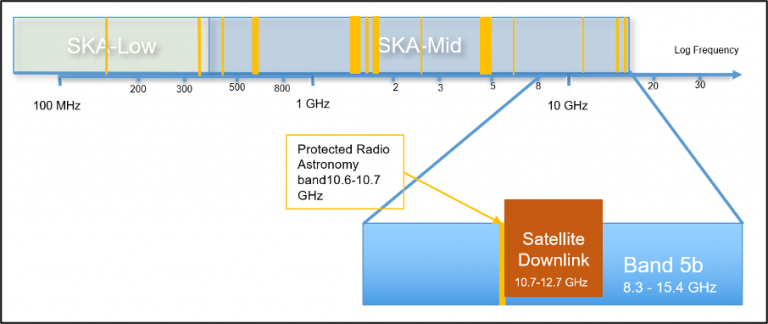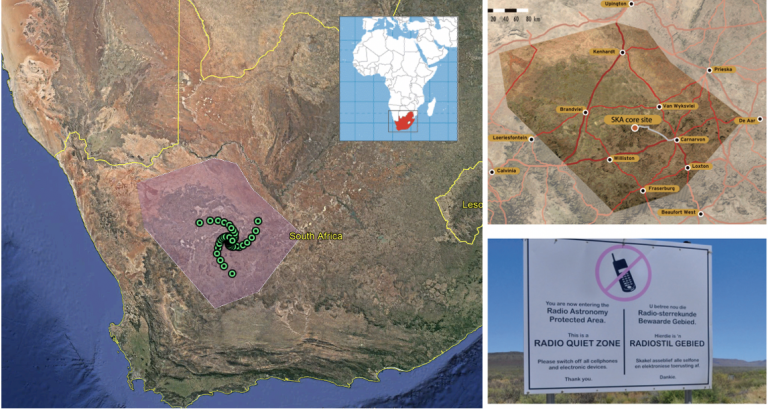SKAO needs corrective measures from satellite ‘mega-constellation’ operators to minimise impact on its telescopes
The study focuses on the impact of the deployment of the principal currently planned space-based systems, totalling 6,400 satellites, on the SKA-Mid telescope soon to be erected in South Africa, which will consist of an array of 197 dishes1.
SKAO’s low-frequency telescope in Western Australia, which uses a different antenna technology and will operate at lower frequencies, is not the subject of the analysis reported here.

Key points and findings (based on deployment of 6,400 satellites)
- The satellites in the various constellation projects will transmit signals within the frequency range covered by the Band 5b receivers of the SKA-Mid telescope in South Africa (one of seven bands planned for the telescope).
- Without specific mitigation actions by the constellation operators, there is likely to be an impact on all astronomical observations in Band 5b.
- This impact includes a loss of sensitivity in the frequency range used by the constellations, leading to astronomical observations in that range taking 70% longer.
- The science impact is most significant for studies of molecular and atomic spectral lines in that range, including complex organic molecules; Class II methanol masers; and a wide range of extragalactic molecular lines.
- Viable mitigation techniques identified by SKAO can reduce this impact on SKA-Mid by a factor of 10, if implemented by relevant satellite operators.
- SKAO remains committed to minimising the loss of scientific discovery through all available avenues. SKAO will continue to work closely with industry on ways to minimise the damage caused by mega-constellation transmissions and is looking forward to a positive response on these proposed solutions.
- For significantly larger constellations, of up to 100,000 satellites, the effect on the SKA would be much worse, potentially threatening the viability of the complete Band 5b for 100% of the time, unless stringent mitigation actions are put in place.
Use of the radio frequency spectrum
Due to their exquisite sensitivity, the two SKAO telescopes will be built in remote locations far away from artificial radio frequency interference. These locations enjoy legal protections, declared as national Radio Quiet Zones (RQZ), which protect them from ground-generated radio signals, such as mobile phones, broadcasting transmitters or Wi-Fi to name a few examples. However, the RQZ status provides no protection against interference from space-borne transmitters.
Radio transmissions from satellite constellations use a frequency range which has been in use by the satellite industry for many years. It sits within the range of frequency observed by the SKA-Mid’s band 5b receivers, and is immediately adjacent to an internationally protected radio astronomy band 2. However, radio astronomy has been able to conduct observations in all these frequency ranges due to the small number of (visible) satellites and their fixed position in the sky (most of them in geo-stationary orbit). The deployment of thousands of satellites in low earth orbit (LEO) will inevitably change the situation as astronomers now face a much larger number of fast-moving radio sources in the sky 3.

Impact on SKA
Elon Musk, the CEO of SpaceX (which is currently deploying the Starlink mega-constellation), said recently in a public statement that:
“… Starlink won’t be seen by anyone unless looking very carefully and will have ~0% impact on advancements in astronomy.”
The SKAO study shows that, for radio telescopes in general and for SKA in particular, this is not the case and specific mitigation actions will be needed to minimize this impact.
SKAO’s analysis focused on three issues:
- Physical damage: our study ruled out concerns about physical damage to the Band 5b receivers through intense radio signals from the satellites directly illuminating the dishes.
- Saturation of the instruments: very strong interfering signals can saturate the receiver systems and thereby drown out all other signals seen by the Band 5b receivers. As a consequence, all data in that frequency band would be lost, rendering these receivers useless for a portion of the time. For the first phase of the constellation deployments (about 6,400 satellites in total), saturation is predicted to occur for a few percent of the time assuming there is no direct illumination of the dishes by the satellites. For significantly larger constellation sizes (up to more than 100,000 satellites), saturation would be essentially continuous without significant mitigation measures implemented by the satellite operators.
- Scientific impact: our study demonstrated even with the current smaller constellation sizes (of 6,400 satellites), there is likely to be a continuous loss of sensitivity impacting all astronomical observations in Band 5b within the frequency range of the satellite’s transmissions unless mitigating actions are implemented. The science impact of this will be most significant for studies of molecular and atomic spectral lines in that range. This includes studies of complex organic molecules; Class II methanol masers; and a wide range of extragalactic molecular lines.
“There is tremendous scientific and public interest in identifying the origins of life beyond that found on Earth and one of the most promising methods of tracking it down elsewhere in our Galaxy is the detection of complex pre-biotic molecules, whose spectral signatures are concentrated between about 10 and 15 GHz,” says Dr Robert Braun, SKA Science Director. “This is only one of many exciting science goals that depend on sensitive access to this frequency range. The prospect of losing sensitivity in this key frequency band is extremely worrying.”
A direct impact of the lost sensitivity will be a 70% increase in the required integration time – the amount of time astronomers need to look at a particular object in order to observe it clearly – in the satellite transmission range. In other words, each observation in that range will require 70% more time, and therefore only approximately half as many observations can be carried out overall.
“A loss of observing efficiency on top of the expected large oversubscription on the telescope will translate directly into lost science and it is quite possible that the most challenging experiments that might otherwise have been undertaken will no longer be viable at all in these circumstances,” confirms Dr Braun.
Possible mitigation measures
To ensure that the impact of the current and planned satellite constellations is minimised, the SKAO telescope in South Africa has to be actively protected by lowering the power of satellites’ transmissions received at the site. SKAO believes there are different mitigation techniques that can make this possible, depending on the technology of the communications payloads of the satellites.
One of these mitigation techniques is for the satellite transmitters not to point their beams near the SKAO dishes. SKAO would require operators to steer their satellites’ beams away from the telescope site, a measure which would require a simple software modification with no repercussion on the constellation’s deployment, positioning or hardware. While a cost-effective implementation of this solution does depend on the hardware and software deployed on the satellites, operators already use this technique to comply with international regulations when their satellites cross the path between geostationary satellites in higher orbit and their receiving ground stations, for example to avoid affecting telecommunications and TV transmissions.
This mitigation could reduce the impact on the SKA by a factor of 10 over that noted previously and result in a 7% increase of integration time for SKA observations within the satellite transmission range 4. While any loss of sensitivity is regrettable, SKAO recognises the need for compromise between the competing scientific and commercial drivers.
t is worth noting that the commercial incentive for operators to point their satellite beams towards the South African SKA site is already significantly limited, with the national Astronomy Geographic Advantage Act of Parliament regulating the licensing and roll out of the necessary ground-based infrastructure for satellite operators to service users in the area around the South African SKA site.

Thanks to our modelling work, the potential impact of satellite mega-constellations on the SKA is now understood,” says Prof. Philip Diamond, SKA Director-General. “We are building a multi-billion euro state-of-the-art research facility funded by taxpayers around the world, and we need to protect and maximise its ability to deliver innovation and new knowledge for humanity.”
Prof. Diamond adds: “In an effort to be constructive and offer solutions to industry, we have also identified viable mitigation options and modelled them. I’m reassured by Elon Musk’s public statements assuring us that there would be no impact on astronomy and welcome the constructive engagement we’ve had with industry so far. We look forward to satellite operators’ proactive engagement with the solutions we propose here today to safeguard the SKA’s Member States taxpayer investments in the SKA.”
Notes
1 A potential impact on the SKAO telescope in Australia, operating in the 50 MHz-350 MHz frequency range, exists due to signals transmitted from the ground bouncing off satellites and being detected by the SKAO antennas. A full impact assessment of this interference is planned.
2 The International Telecommunication Union (ITU), a United Nations agency, through its Radiocommunication sector regulates the international use of the radio spectrum and satellite orbits. Radio astronomy was first officially recognised as a radiocommunication service in 1959, when it was agreed to protect certain narrow bands for radio astronomy observations. Satellite manufacturers are bound by international agreements under the ITU, which guarantee radio astronomy protected bands, including that at 10.6-10.7 GHz, are not affected by their transmissions if strict control is exercised over the spill over from one band to another – a perennial problem with other satellite operators.
However, the field of radio astronomy has developed tremendously since and new scientific knowledge has required radio astronomers to expand their observations beyond the traditionally protected bands. The majority of SKA’s Band 5b – and indeed of all of the SKA bands – is therefore not protected by ITU regulations. Current legislation in place to protect the sites is also only enforceable on ground-based emitters, while airborne and space radio communications fall under the ITU and are not similarly restricted.
3 Recent filings to the FCC have revealed operators’ plans to increase the mega-constellation size to tens of thousands of satellites. This dramatic increase in numbers would mean that, if left unmitigated, the effect of these constellations on the SKA would be much worse than predicted above, potentially threatening the viability of the complete Band 5b for 100% of the time. This would require further action and more stringent mitigation in order to protect the SKA. Filing with the FCC allows operators to service the US market and is a useful collecting point for information on Industry’s intentions for satellite constellations. The telecoms regulators of home countries of the major proposers, currently UK, Canada, France, Netherlands, Norway, Luxembourg, Liechtenstein and China will also have a role to play in promoting such mitigations.
4 In addition to identifying this mitigation solution, SKAO has gone further and modelled this solution for a constellation serving population centres surrounding the SKAO site in South Africa. SKAO determined that the satellite beams would need to be steered by a minimum of 20 degrees away from the site to be effective. As the SKAO model has some uncertainty around it, since we don’t have full access to all the technical information and tools, SKAO encourages satellite operators who own the necessary data to develop a precise model, so that the impact can be better understood, both on the telescope and on potential accessibility issues for those populations.




